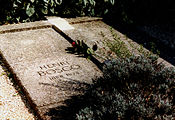Lourmarin
| Lourmarin | ||
|---|---|---|

|
|
|
| region | Provence-Alpes-Cote d'Azur | |
| Department | Vaucluse | |
| Arrondissement | Apt | |
| Canton | Cheval-Blanc | |
| Community association | Luberon Monts de Vaucluse | |
| Coordinates | 43 ° 46 ′ N , 5 ° 22 ′ E | |
| height | 169-818 m | |
| surface | 20.18 km 2 | |
| Residents | 1,076 (January 1, 2017) | |
| Population density | 53 inhabitants / km 2 | |
| Post Code | 84160 | |
| INSEE code | 84068 | |
| Website | Site officiel de Lourmarin | |

|
||
Lourmarin is a French commune with 1,076 inhabitants (at January 1, 2017) in the department of Vaucluse and the region Provence-Alpes-Cote d'Azur . The municipality is classified as one of the Plus beaux villages de France ( Most Beautiful Villages in France ).
geography
The place is between Avignon (69 km) and Aix-en-Provence (41 km) on the passage from the small to the large Luberon in Provence . The municipality is part of the Luberon Regional Nature Park .
history
In the 12th century a fortress was built in the place, which was renovated in the 15th century by Foulques d'Agoult in the Renaissance style and as a castle. Also in the 12th century, the Saint-André de Villeneuve-lès-Avignon monastery in Lourmarin maintained a priory that lasted until the beginning of the 14th century and a parish church, which was destroyed in the 15th century. The profits from the lands belonging to the priory were collected by the abbey.
At the end of the 15th century, many residents migrated from the higher alpine valleys and settled in the plain. Lourmarin also benefited from this wave of economic emigration. In 1470, Foulques III d'Agoult had a Waldensian colony fetched from Piedmont . They settled permanently in the village, and so Lourmarin became an important base for the Waldensians. Over the next thirty years this movement dominated 24 villages in the region. The swampy lowlands in the south and finally the northern slope of the Luberon were reclaimed. In April 1545, the village, populated by Waldensians, was sacked by the troops of the French naval officer Paulin de La Garde on the orders of the first President of the Parlement of Aix (also known as the Parlement of Provence), Jean Maynier, lord of the Oppède. After the massacre, in which around 3,000 Waldensian residents in the region were killed, some of the survivors returned to Piedmont, while others emigrated to the Central American province of Darién . After the revocation of the Edict of Nantes in 1685, some of the resident Huguenots fled to the Spanish Netherlands and finally on with the ships of the Dutch East India Company to South Africa, where they joined the Boers . A hamlet called Lormarin still exists in South Africa today .
From 1920 the castle was renovated.
Lourmarin and the "Mediterranean spirit"
From 1927 writers' conferences took place in the castle of Lourmarin. a. Jean Grenier , writer and publicist as well as teacher and role model of the philosopher and writer Albert Camus , took part. In the 1930s Grenier published two essays with the name "Lourmarin" in the title: Terrasses de Lourmarin ("Terraces of Lourmarin") and Sagresse de Lourmarin ("Wisdom of Lourmarin"). Lourmarin became a metaphor for the “Mediterranean spirit” for both Grenier and Camus: “The southern French village, whose name Camus first came across in Grenier's books, is home to the Mediterranean spirit for both teachers and students; a place free from the noise of Europe. ”Camus bought a house there and is buried in the local cemetery.
Population development
| year | 1962 | 1968 | 1975 | 1982 | 1990 | 1999 | 2009 |
| Residents | 612 | 615 | 685 | 858 | 1.108 | 1,119 | 1,000 |
Town twinning
- Ötisheim , Baden-Württemberg
Attractions
- The castle Lourmarin from the 15th century. It was repeatedly rebuilt and enlarged in later years. It is said to be the oldest Renaissance castle in Provence.
- The church of Lourmarin
- The largest Protestant church (French: Temple ) in the Vaucluse department, built in 1806
- A windmill that lacks the wings
- Various fountains in the palace gardens and in front of the church
- The tombs of Albert Camus and Henri Bosco
Community partnerships
Lourmarin has a partnership with Ötisheim in Baden-Württemberg, Germany and Żyrardów in Poland.
Personalities
- Albert Camus (1913–1960), French philosopher and writer, winner of the Nobel Prize for Literature, lived in the community in the house he had bought in 1958. His grave can be visited in the Lourmarin cemetery.
- Henri Bosco (1888–1976), French writer. Lived and owned a house in the parish. He has rendered outstanding services to the preservation and restoration of the castle. His grave can also be visited in the Lourmarin cemetery.
- Peter Mayle (1939–2018), British writer, lived in the community.
- Philippe Henri de Girard (1775–1845), French technician, born in Lourmarin
Web links
- Website of the community
- Website of the castle
- Small photo gallery on Provence en images
Individual evidence
- ↑ Lourmarin on Les plus Beaux Villages de France (French)
- ↑ Iris Radisch : Camus. The ideal of simplicity. A biography . Reinbek near Hamburg 2013, ISBN 978-3-498-05789-3 , pp. 78, 81
- ↑ DB-CITY





